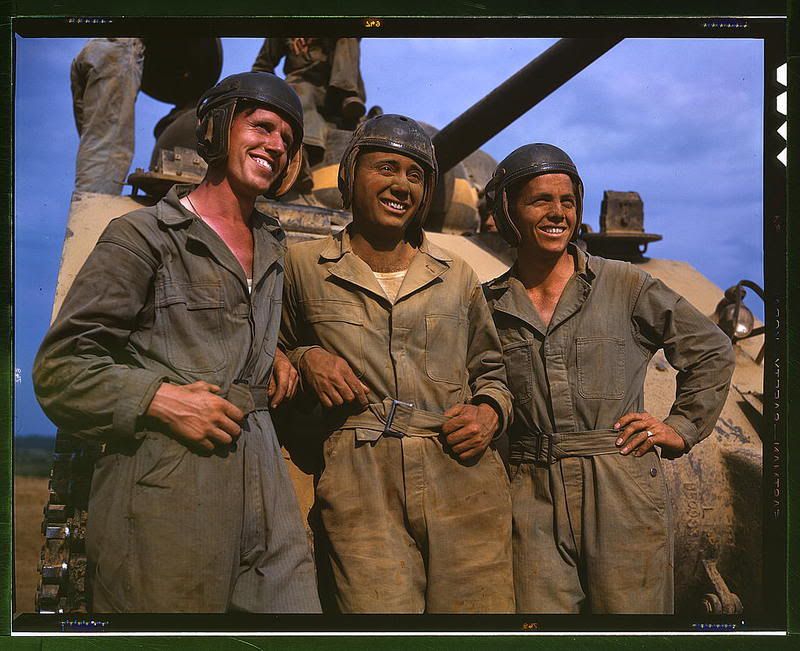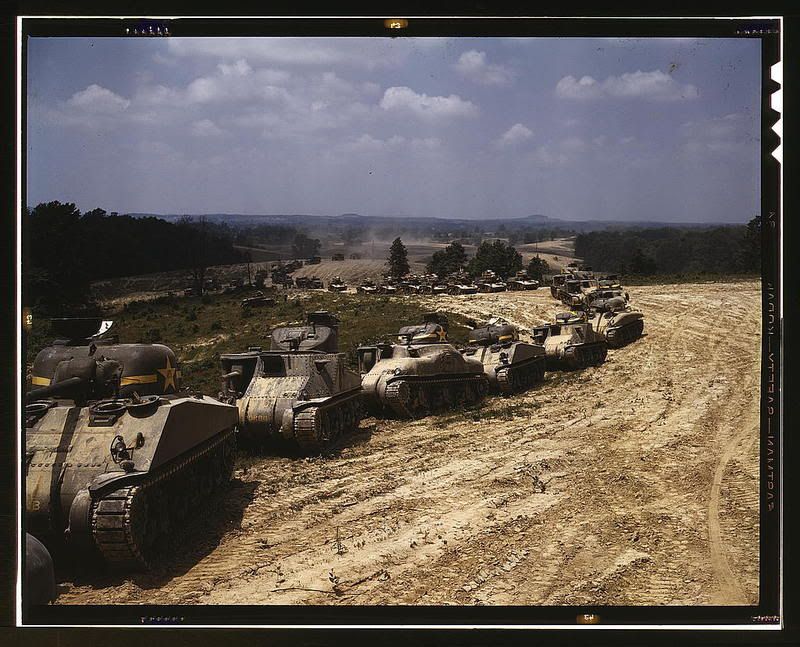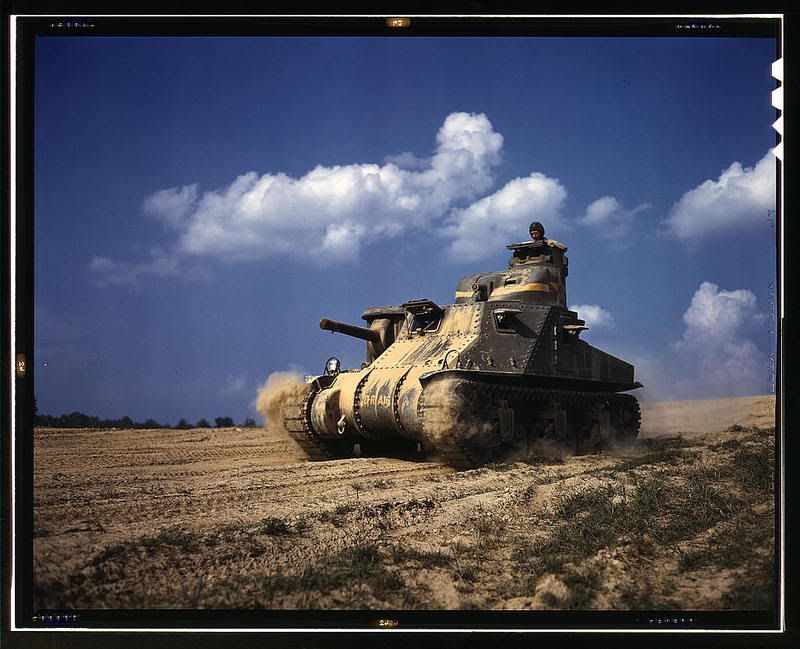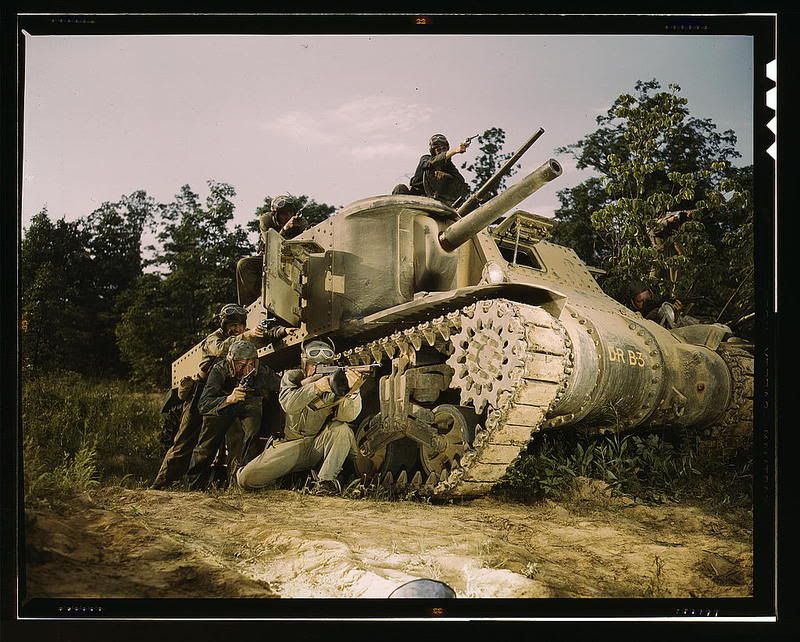
M1A1TC
-
Posts
1,631 -
Joined
-
Last visited
Posts posted by M1A1TC
-
-
All of the M1 models can use 50 cal from inside the vehicle. There is a small handle with a trigger and a thumb switch that TC uses to move to 50 cal around, and he aims it through the periscope. The TC has to stick out to reload it though.Originally posted by c3k:There are various models of the M1 tank in this game. How do I know which ones can use the .50?
Any thoughts?
BF.C?
Thanks,
Ken
-
Dont forget Vietnam mod - M113 was used extensively there, since it was created in the 1960's
-
Steve
I remember asking BFC about decal/patch system back in CMBO days. It would be awesome to just pick a unit from a drop-down unit menu list in the editor,pick the unit you want, and the game will automatically apply that patch/decal to all uniforms and vehicles
Ive also been asking for variety in vehicle and infantry models. We finally for that in vehicles, but not in infantry yet. It would be nice to have several models to choose from. Id love to see a model with regular kevlar helmet, one with new style, one with baseball hat (to mod into PMC forces), one with boonie hat, goggles on/off,etc
I know that the models have to fit/match into vehicles, but maybe you can work some magic
-
I knocked over a 30 to 40 foot pine with my track once and it fell on top of the vehicle. We had to tie it off to another tree and drive out from under it. Good thing I was driving because I would have kicked my driver for doing something like that.Originally posted by SgtMuhammed:</font><blockquote>quote:</font><hr />Originally posted by M1A1TankCommander:
You should have seen some big pines trees I have knocked over with my tank
 Splinters were flying everywhere. I wouldnt try that with an oak for example
Splinters were flying everywhere. I wouldnt try that with an oak for example  </font>
</font>
-
It should be noted on that very same webpage was a link entitled "M113 Gavin vs Stryker"Originally posted by MikeyD:Hah! here's an excerpt from GlobalSecurity.org. Note the 'passion' of the writer:
</font><blockquote>quote:</font><hr /> One observer wrote that "In more than 30 years working in the defense industry, I have never, never heard anybody use the name “Gavin” for the M-113. Not in the US nor in any of the many countries that use the vehicle. Not in the military forces, not in the companies that build and equip it, not in the groups that retrofit and repair it. This usage appears not only to be “unofficial”, it is entirely fictional and I believe that you may have been the victim of a hoax or deliberate disinformation."
 </font>
</font> -
I am sure he meant M113, though no one "in the buisness" calls it that
"Initially nick-named "The Green Dragon" by the enemy, the M113 served in all areas of Vietnam throughout the war and was to become one of the most successful armored vehicles of all time. Unlike many other Army vehicles, the M133 does not appear to have acquired an official name or even a widely used nickname. Some advocates have indicated that the M113 is also nicknamed the "Gavin", after an Army general who was influential in the development of the M113 in the 1950s. This is not however, an official designation, and there is some question about the extent to which actual users of the system use this name. A similar point arises with respect to the M8 AGS, which some unofficially call the Buford, despite this also being an unofficial naming. One observer wrote that "In more than 30 years working in the defense industry, I have never, never heard anybody use the name “Gavin” for the M-113. Not in the US nor in any of the many countries that use the vehicle. Not in the military forces, not in the companies that build and equip it, not in the groups that retrofit and repair it. This usage appears not only to be “unofficial”, it is entirely fictional and I believe that you may have been the victim of a hoax or deliberate disinformation."
According to the manufacturer
"The M113 is the largest family of armored tracked vehicles, with over 80,000 vehicles worldwide and more than 40 different variants. Today's M113 is fully equipped to meet the battlefield challenges for mobility, reliability, survivability, and transportability. Our M113 vehicles will represent the bulk of the combat vehicles included in the U.S. Army's Force XXI vision."
I was surprised that it wasnt included. As a tanker, Ive seen and even drove a lot of M-113s and M577s
[ March 11, 2008, 07:38 PM: Message edited by: M1A1TankCommander ]
-
No problem, it keeps it up, so I hope someone official can respond please to my initial post
-
The humvee models in CMSF were created before use of gunner shielding was widespread
-
Found some color photos from 1940's that I really like





-
"Lindsay Lohan, Jessica Biel, Jessica Alba"
First one doesnt float my boat, but the last two I would definatly "mod"
BTW, my Up-Armored Humvee mod has 830 downloads
 Thats pretty good
Thats pretty good -
Or as I like to say it: "You Can!"
-
Searching for images of Hohenfels I found several of my old platoon.Originally posted by SgtMuhammed:</font><blockquote>quote:</font><hr />Originally posted by Vergeltungswaffe:
The net makes this world smaller and smaller.
It's a small Army. </font>
-
You should have seen some big pines trees I have knocked over with my tank
 Splinters were flying everywhere. I wouldnt try that with an oak for example
Splinters were flying everywhere. I wouldnt try that with an oak for example -
Mine is not a low horizon, but a high mountains mod
-
We can both share the thunder, there is plenty to go around. Cheers mate
-
Wow, those screenshots make me want to buy the game. Is it any good? I wasnt impressed with the demo
-
Have you been in theatre in RL? I have, believe me, it's not all sand dunes like in the movies. There is a lot of bushes in the desert
-
There is already fire graphics in-game. All you need it to code the spreading of fire from one spot (tile) of grass with direction of blowing wind. The grass tiles will be replaced with burned grass tiles, same as tree models replaced with burned tree model
How hard is that?
If they could code burning grass in CMBO 8 years ago, why not now?
-
Have you seen videos for Far Cry 2? You can set fires, watch them spread with the blows of wind, burn grass and trees, etc. Seems like should be easy to implement in CMSF. We already have fire,directional wind. Why no burning grass?
-
Cpl Steiner
Isnt that what I said?
BTW, Semigall, I am from Riga, Latvia!! Privet!
-
1. In the first turn, use "move" command to place your units withing the deployment area that is colored
2. Select infantry, place cursor on a vehicle. If it turns green with a down arrow, that means the vehicle will hold those passengers. Click on the vehicle to place them there. If the cursor is yellow, the ride is full, or doesnt have passenger ability (MGS Stryker)
3. Yes, the AI will just sit at the start positions
-
Didnt CMBO editor have a selection of buidlings, buildings on fire, and ruins?
-
Those screenshots are heavily modded. RommL, why do you create a new thread for each screenshot you make? There are like 4-5 threads now with nothing but your screenshots
[ March 07, 2008, 08:15 AM: Message edited by: M1A1TankCommander ]
-
Its always easier to clear a building from the top down. Thats why, for example, SWAT officers fast rope on the roofs

Transformation of the US Army
in Combat Mission Shock Force 1
Posted
After five years, the Iraq war is transforming the military By Nancy A. Youssef, McClatchy Newspapers
Sun Mar 16, 6:00 AM ET
WASHINGTON — When U.S. forces crossed the Kuwaiti border into Iraq in the pre-dawn hours of March 20, 2003 , the military set out to shock and awe the Middle East with the swiftest transformation the region had ever seen.
Five years and hundreds of billions of dollars later, it's the U.S. military that's been transformed. The efficient, tech-savvy Army , built, armed and trained to fight conventional wars against aggressor states, is now making deals with tribal sheiks and building its power on friendly conversations with civilians.
Instead of planning for quick, decisive battles against other nations, as it was five years ago, today's American military is planning for protracted, nuanced conflicts with terrorist groups, insurgents, guerrillas, militias and other shadowy forces that seldom stand and fight.
The staples of American military doctrine that have developed since the Civil War — artillery, armor, air power, speed and overwhelming force— are of limited use against enemies who blend into civilian populations.
Five years after the U.S.-led invasion of Iraq , the military is being reconfigured to fight insurgencies, but its evolution has been an unplanned, improvised affair, a series of course corrections in the midst of the wars in Iraq and Afghanistan . Some changes have been simply last-ditch efforts to stop the violence against Iraqis and U.S. troops, and some say the changes impair the military's ability to fight a conventional war against a "peer competitor."
Divisions are dispersed into what the military calls a more modular Army so smaller units can be moved throughout Iraq . The military has rolled out new vehicles to thwart high-powered explosives. It's set up new training centers and given captains and colonels far more leeway to lead at the local level, not simply follow a general's orders.
Pentagon leaders call this the military of the future.
"Clearly the training now is almost exclusively focused on COIN (counterinsurgency) because that's the fight we are in. And it will continue that way as long as the fight stays at the level that it is," said Adm. Michael Mullen , chairman of the Joint Chiefs of Staff, in an interview with McClatchy .
In the last five years, the military has gained "speed, agility (and) flexibility that . . . we didn't have as a much heavier force" a few years ago, Mullen said.
It's a big departure from the transformation that then-Secretary of Defense Donald H. Rumsfeld promised in the months leading up to the war. Under his plan, the Army would be smaller and rely more on precision air attacks and the latest technology.
Indeed, the war in Iraq was supposed to last a few weeks. The U.S. would dispatch the Iraqi military, overthrow Saddam Hussein's regime, install a new government led by Iraqi exiles and introduce freedom, democracy and a market economy.
Within days, however, the U.S. lost control. Looters took to the streets, and an insurgency took root. The U.S. installed an American occupation government and tried to secure a hostile nation rather than a grateful one.
Back then, there was little talk of counterinsurgency. But the new Army Field Manual puts counterinsurgency on a par with conventional war. "Winning battles and engagements is important but alone is not sufficient," it states. "Shaping the civil situation is just as important to success."
But while the Army has intellectually embraced counterinsurgency, it hasn't said how it will build a force that can fight both conventional wars and counterinsurgency campaigns. How should it train its soldiers? What kind of enemy will the U.S. face? So far, military leaders cannot agree on those fundamental questions.
By adopting a new mode of warfare, "the Army is a python that has just swallowed a pig," said a U.S. Army officer who spoke on the condition of anonymity in order to speak more candidly. "It's not clear to me it understands how hard the digestion process is going to be."
"The Army is going to have to build organizations optimized to do (post-combat) stability operations, and that's not what this Army wants to do," the officer added.
Lt. Col. John Nagl , who co-authored the U.S. military's 2006 counterinsurgency manual with Gen. David Petraeus , now the top American military commander in Iraq , questions whether the Army is serious about counterinsurgency.
"The real question is: How does the Army react to the (new field manual)? Can the Army transform itself to be as effective as possible in future battles, which are going to look a lot like Iraq and Afghanistan ?" Nagl said in an interview with McClatchy .
Some think that Iraq is a temporary problem and that the U.S. shouldn't engage in nation-building, as called for under counterinsurgency strategy.
Some think the Army isn't prepared for both kinds of war. Pete Geren , the secretary of the Army , testified on Capitol Hill last month that as the Army steps up counterinsurgency training, it's losing its conventional war skills.
"Our goal is full-spectrum readiness. And right now we're— we're not able to claim that," Geren said. "We are not able to properly organize, train and equip for the rest of the spectrum of operations."
Gen. George Casey , the Army chief of staff, has repeatedly warned that the Army is strained by having 160,000 troops in Iraq . Other Army leaders estimate that the U.S. must reduce its deployment to 12 combat brigades from the current 18 or find itself at the "breaking point."
The war in Iraq has required some soldiers to serve multiple tours of up to 15 months and to remain in uniform longer than they signed up for. Before the war started, soldiers generally served six-month tours in combat zones.
Mullen acknowledged the friction between counterinsurgency and conventional warfare.
"I think that (tension) will be constructive, and actually with what we learned through counterinsurgency, potentially very creative tension as we move to the next several years to get back to a broader spectrum of training."
The military's embrace of counterinsurgency came only in the last 18 months as soldiers noted measurable security improvements in Iraq . In the early years of the war, only a handful of military commanders spoke of the importance of economic development, respecting civilians and employing military might cautiously.
Back then, many ridiculed using "soft power" against what they considered a ruthless enemy. Soldiers said they were in Iraq to fight.
These days in Iraq , soldiers say they're likely to spend the rest of their careers in places such as Iraq , reaching out to civilians and fighting major battles only occasionally. Instead of generals giving orders from behind the front lines, captains and colonels will be forced to adapt as they maneuver through local, tribal politics. And many soldiers say those mid-level leaders will base their decisions on their experiences in Iraq .
Sgt. John Pierce Senkarik , 25, of 1st Brigade, 4th Stryker Brigade Combat Team, is serving in Diyala province, and could be one of them. Senkarik, of Pensacola, Fla. , comes from a family imbued with military history, and he once thought he'd fight the same kind of battles his forebears did. But since he signed up, he said, he's seen a transformation within the Army .
Senkarik, who's serving his second tour in Iraq , said he plans to stay in the military so the Army can capitalize on his experiences there.
"The Army is filled with junior leaders and middle-level leaders who have a vast amount of combat experience in counterinsurgency, in urban combat," he said. Mid-level officers will lead and be "responsible for the up-and-coming Army ."
( Steve Lannen of the Lexington Herald-Leader contributed from Diyala province, Iraq .)